Choosing the right QA outsourcing service isn’t just about considering the basics, such as their experience, certifications, and client feedback and reviews. You should evaluate their process for writing and maintaining tests, as this directly impacts your ability to ship fast and with confidence.
From what we’ve seen, most QA outsourcing services use outdated, legacy frameworks like Selenium to write automated tests. We recommend avoiding these services for the following reasons:
- Frequent test breakages: These automated tests are brittle because they search for locator IDs in your codebase to know what to test. If locator IDs change, their tests break because they require an exact match. Teams must wait for service providers to update tests manually before shipping again.
- Unreliable test results: Open source frameworks test code elements in an application’s codebase and not how the application renders on the UI, causing them to miss UI bugs not present in the code.
- No support for multi-tab or desktop workflows: Open source frameworks can only test within one browser window at a time, so teams can’t cover critical user paths such as signing in with a link sent via email or completing a checkout that opens a third-party payment modal.
- Can’t embed into your team like an in-house QA: Many testing services employ overseas personnel who don’t speak fluent English, so they don’t develop the same deep familiarity with your features and development process as an in-house QA would.
Therefore, it’s essential to evaluate how a QA service addresses each of these considerations before outsourcing to them.
In this guide, we start by sharing how we approach the four shortcomings of most testing services mentioned above at Rainforest QA.
Then, we compare alternative options on the market and how their processes and methodologies compare.
Schedule a quick demo to learn more about how Rainforest QA helps development teams outsource QA for less than half the price of a QA engineer.
1. Rainforest QA
Fast, dependable, and cost-effective QA testing services built to keep up with your release speed

Rainforest QA is a U.S.-based automated testing service that uses proprietary technology and virtual machines (VMs) to test your application — helping software development teams catch bugs reliably and ship faster than with services relying on open-source tools. Rainforest clients get a dedicated QA team who:
- Write and maintain automated tests inside the Rainforest software.
- Facilitate parallel testing — no need to wait for someone to hit ‘run’ — so you get results for full test suites in just four minutes.
- Triggered tests automatically within your CI/CD pipeline, giving developers fast feedback on every build — without adding extra steps or slowing down the release cycle.
- Use our patent-pending AI to automate test maintenance and verify all AI changes.
Here’s what clients think about our approach to QA (quality assurance) testing:
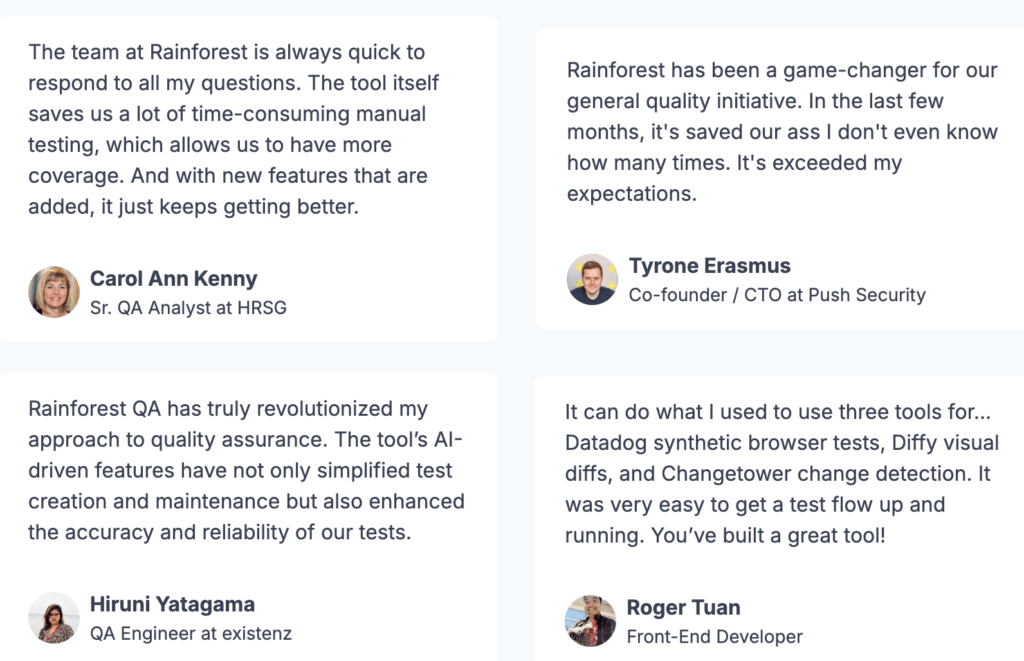
How Rainforest allows software development teams to ship code fast
As mentioned earlier, most outsourcing services write automated tests using outdated, brittle tools.
These tests execute actions on elements (e.g., buttons, tables, form fields) in your application’s code or visual layer. If these elements change, say a developer changes a form field’s locator ID from “user-name” to “user-ID” or updates a form field to a dynamic UI control, the test breaks — not because it found a bug, but because it’s still looking for the previous element.
So, whenever your application changes, outsourced services need to rewrite their test scripts to match the latest version. During this time, your team must either delay releases or ship changes anyway and trust that there are no bugs in their code.
To help teams improve shipping speed, we built the Rainforest platform with a patent-pending AI trained on thousands of test scripts over the past decade. This training data enables our AI to distinguish between bugs and intentional changes.
For example, if a developer updates the layout of a checkout page, the AI can recognize it as a deliberate design change rather than a bug.
The AI will self-heal by automatically updating test scripts to reflect changes. However, it will still inform your Rainforest test manager of the change, who will double-check it. This self-healing feature enables you to ship as soon as new code is released.
Here’s an example of the Rainforest AI self-healing because of intentional changes:
On the other hand, if the “Submit” button disappears unexpectedly, for example, the AI will alert your Rainforest test manager to review it and potentially filter any false positives.
If your test manager confirms a bug, the Rainforest platform creates a Jira ticket and tags a developer to fix it. Everything developers need is right in the Jira ticket — screenshots, video replays, HTTP logs, and more.

The Rainforest AI speeds up test creation — outsourcing software testing to Rainforest is 3 times faster than code
Besides maintaining tests, outsourced services are so slow because of the time it takes to code tests for every new feature or update.
With many legacy frameworks, like Playwright and Selenium, QA teams must code every action and requirement in each test case and step, such as the element’s color, height and width, spacing, rendering behavior, and pixel alignment, among other things.
The Rainforest AI can speed up test creation because test experts don’t need to code. They can describe each test step in plain English, and the Rainforest AI converts their description into test scripts.
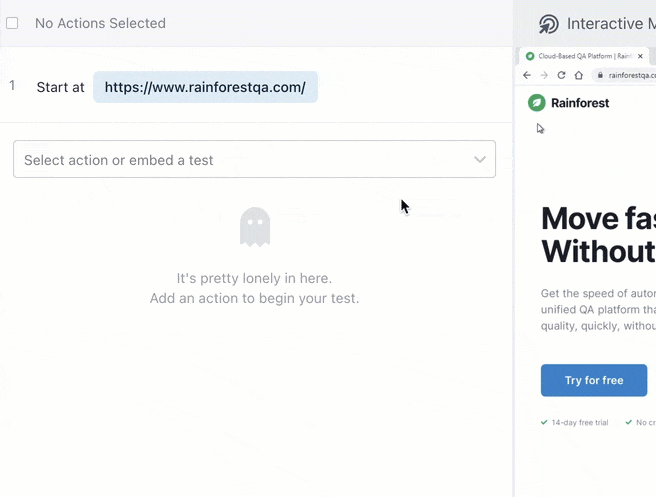
Because of this, creating tests inside Rainforest is three times faster than writing code.
How Rainforest reliably catches user-critical bugs
A fundamental part of choosing a QA outsourcing service is understanding how reliable their tests are at catching bugs in important user workflows.
Many tests fail to detect bugs because they evaluate locator IDs in the code rather than the visual layer that users interact with. For example, if a test wants to verify whether a button works, it looks for the locator ID and checks if it takes users to the correct URL. It doesn’t interact with the button from the visual layer.
While evaluating code is an effective way of testing an application’s functionality, it often misses visual regressions since these typically don’t appear in the code.
For instance, a form field could technically exist in the code, but a broken style rule might make its text unreadable by setting the text color to match the background. Code-based tests struggle to reliably flag these visual regressions because they see the form field element ID in the code and pass the test.
We created Rainforest because of these limitations with code-based tests.
Rainforest runs automated tests that validate your application like a manual user would. We simulate user actions on full VMs, then use image recognition to identify and click on elements through the visual layer.
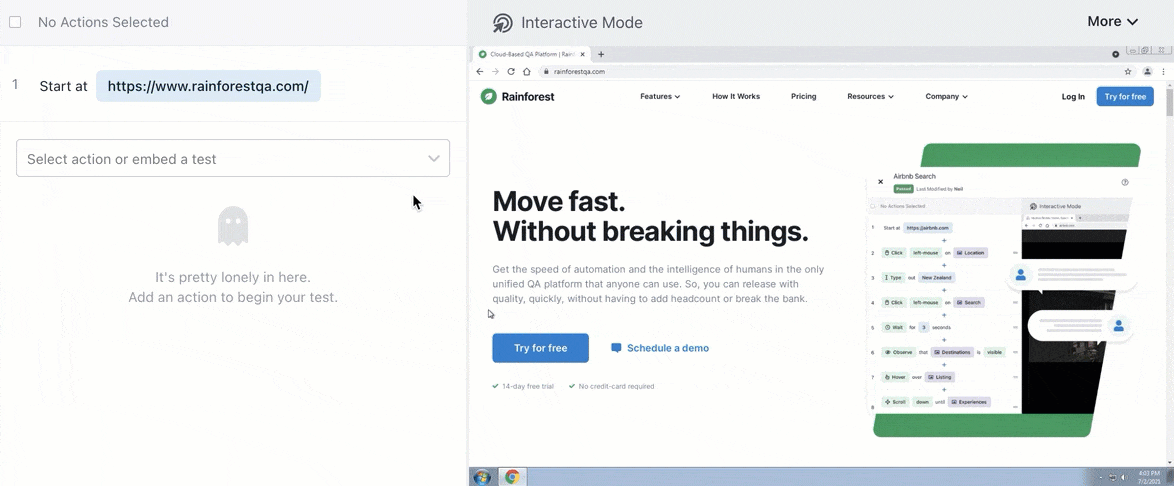
So, if a style error makes the text unreadable, Rainforest will catch it and flag the test as failed.
Here’s a Flux client case study that covers how they utilized Rainforest’s visual-first testing to reduce the number of bugs in critical user paths.
Rainforest can test anything that appears on screen
In addition to testing code elements rather than visual elements, many outsourcing services are unreliable because they can only test actions performed within a single browser tab. They can’t test workflows that span multiple tabs or involve desktop applications. That gap lets bugs go undetected and reach users.
This limitation is because legacy testing tools like Selenium are very limited and can’t simulate complex interactions such as those outside the browser.
Rainforest performs automated tests inside VMs, replicating users interacting with elements in your application inside a clean, controlled virtual environment. By running tests inside full VMs, we can test anything that appears on the screen.
Here’s an example of how a Rainforest test verified whether users could download Brave Browser.

Rainforest mimics how an internal hire integrates with your team
When surveying engineering leaders, we’ve found that one of the main reasons many hesitate to outsource and prefer hiring full-time in-house teams (despite the greater costs) is collaboration problems.
Most services struggle to work closely with teams and learn about project requirements, internal protocols, and testing nuances.
There are multiple reasons for this disconnect. Services frequently rotate test personnel, causing a loss of knowledge after each change. Testing teams also work overseas and outside U.S. time zones, so they can’t join meetings or speak fluent English.
As a result, developers often find themselves fixing the work of QA teams and doing a lot of project management work. Sometimes, it feels faster and easier to write the tests themselves, putting them right back where they started: stuck with the burden of creating and maintaining tests.
At Rainforest, we designed our outsourcing services to mimic internal hires as closely as possible.
We do this by assigning two dedicated test managers to your account long-term. This continuity ensures our test managers can gather deep knowledge of your application and your team’s focus areas.
Plus, test managers work in your time zone and speak fluent English, so they can easily join team meetings or jump on a video call whenever something needs clearing up.
Rainforest gives you full control and clear visibility into your test suites
The testing process of many outsourcing services occurs completely independently from your team’s workflows; nobody on your team can see what user paths the service is testing, the results of those tests, or the software quality and usability. It’s hard to know whether all your key user workflows are really being covered.
At Rainforest, we structured our testing process to give you maximum visibility into what we’re testing. You or anyone on your team can log into the Rainforest dashboard, view detailed test results in real time, watch video replays of test runs, and easily identify which tests passed, failed, or were flagged for review.
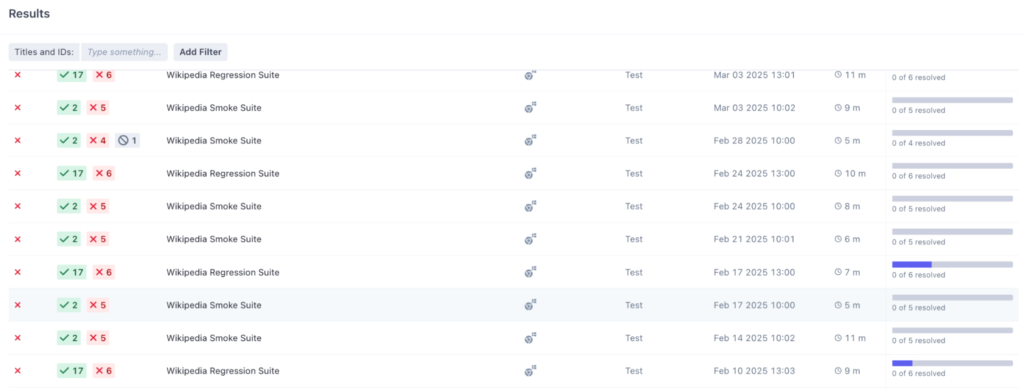
You can also navigate intuitive reports, filter by test status, and get a deep understanding of your product’s quality without digging through logs or complex tooling.
Additionally, because tests are in plain English, anyone on your team can understand them, even non-technical employees who cannot read code.
If your QA strategy changes or you need a new workflow prioritized, simply message your test manager via Slack or jump on a call. You can even write your own tests by describing the steps in plain English.
Reliable QA Outsourcing Company Designed to Improve Time-to-Market
Book a demo call to see how our QA outsourcing can help you ship production-ready code fast and free your developers from testing.
2. Testlio

Testlio is an end-to-end QA service powered by a proprietary platform that offers a mix of functional and non-functional testing. It provides automated testing services, and development teams can use its network of global testers for manual testing.
Their crowd-testing approach is a major strength — it allows companies to utilize a wide pool of testers working across different devices, regions, and user scenarios. This results in broader test coverage and feedback that closely reflects how customers experience software products.
Testlio also has a hybrid testing option available: experienced QA leads shape the test strategy, while distributed testers handle execution — bringing together professional oversight and round-the-clock testing.
However, like many traditional QA vendors, Testlio relies on open-source tools for writing automated tests. These tools focus on the underlying code rather than the visual interface, which can miss visual bugs or UI issues.
In contrast, platforms like Rainforest test the product the way users actually see and interact with it, making it easier to identify what really matters before launch.
Read more: The best Testlio alternatives in 2025
3. A1QA

A1QA is a dedicated software testing company specializing in functional QA, helping businesses ensure their applications meet technical and user expectations. Their approach to functional testing is rooted in thoughtful test planning and a combination of manual and automated techniques.
By integrating with DevOps pipelines, A1QA can catch issues early in the development lifecycle and reduce the cost and complexity of fixing bugs later on. A1QA also offers performance testing, usability testing, compatibility testing, mobile application testing, and more.
A1QA’s testing capabilities span mobile platforms, web applications, and enterprise systems. On its website, it claims to be able to onboard clients quickly, with automated tests typically up and running in just a few days.
However, it’s important to note that A1QA relies heavily on open-source testing solutions like Selenium to power its test automation. While widely used, these frameworks are outdated and brittle. Tests are often tied to underlying code elements and can break even with small changes. This fragility increases maintenance costs and slows down development velocity.
As a result, it’s unclear what systems A1QA has in place to deliver fast, low-maintenance, user-focused testing at scale.
4. QASource
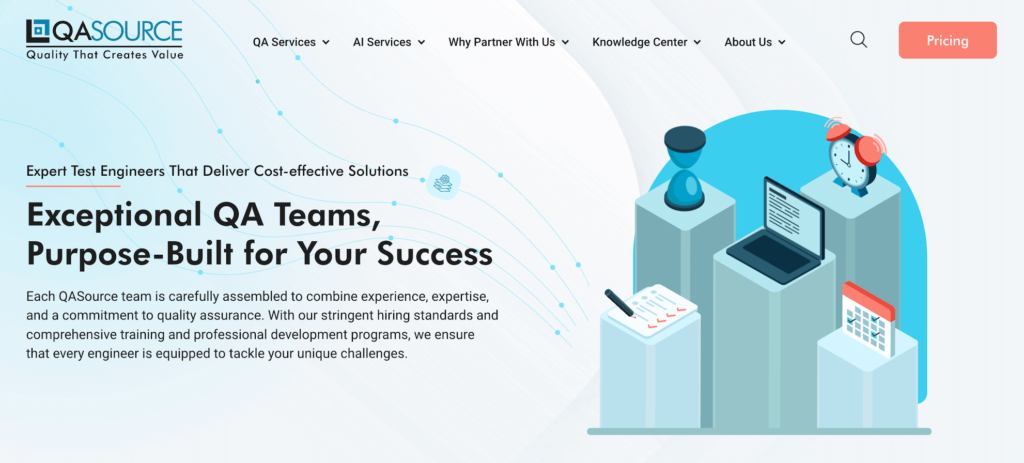
QASource is a long-standing software testing provider and QA consulting firm in the U.S. with delivery centers in India and Mexico.
One of the company’s strengths lies in its ability to integrate closely with engineering teams. They provide dedicated QA engineers who can embed into your existing workflows, whether you’re using Agile, Scrum, or custom development processes. Their services cover everything from manual and automated testing to performance, API, scalability, and security testing.
QASource is especially well-suited for companies looking for long-term QA partnerships. They offer flexible engagement models, consistent communication, and the ability to tailor their approach to meet business needs.
That said, like many traditional QA vendors, QASource often relies on open-source testing tools like Selenium and Appium, which tend to be fragile — tests can break easily when the UI changes, even slightly. This can lead to ongoing test maintenance overhead, slowing release cycles, and pulling developers back into the QA process.
Additionally, QASource’s model is largely code-based. This means their tests validate backend logic and functionality, but they may miss visual bugs that impact real users.
5. Qualitest

Qualitest is an outsourced QA testing service with automation testing options such as end-to-end testing, regression testing, integration testing, non-functional testing, mobile app testing, user experience testing, and more.
What we like about Qualitest is its flexible engagement options. If a development team’s main priority is testing at a low cost, Qualitest can have overseas test personnel run and maintain tests for a lower price — the drawback is that personnel work outside your timezone and struggle to integrate into your team and workflows. If development teams prioritize collaboration, Qualitest can assign test personnel within the U.S.
It’s worth noting that Qualitest relies on outdated, open-source tools like Selenium for writing tests. As we covered earlier, these tools are well-known for being fragile. Because of this, there are doubts about how much their process helps teams release faster.
Outsource QA to Rainforest QA and release high-quality software fast
You can learn more about how software testing services can fit your team by booking a quick demo here.
